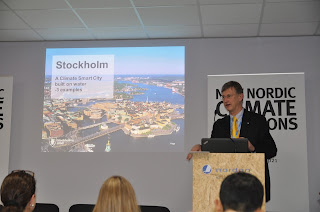José
Jara(Argentina), Giulia Motta Zanin (Italia)*
Nowadays, adapt
to climate change is necessary. Some realities are more fragile as others and
the impacts range from extreme rainfall, droughts, rising sea levels and
flooding is raising and affecting them more and more.
To better
understand what is happening, is useful to speak through three significant
examples being part of the C40 Cities: Amman (Jordan), São Paulo (Brazil) and
Stockholm (Sweden). The C40 Cities is a network of 82 megacities working
together to tackle climate change.
Firstly, Akel
Biltaji, from Amman, Jordain, spoke about the last flood on 2014. He said "We received the highest possible density of rainfall
in the shortest time-span and in a concentrated area, infrastructure managed to
drain the flood within 2-3 hours so we can say it works, but it just couldn't cope with the volume of this
storm. The Quran says: God has created
everything in the right proportion" meaning that there should be an
equilibrium, it is us human beings that have unbalanced that equilibrium, how
to be prepared for another heavenly disaster"? Sadly, they don't
have solution to that, because the weather is unpredictable.
Also Joao R.
Capobianco, that represents the State of Sao Paulo, Brazil, spoke about the
problem of the water production system because they are suffering from droughts
on that areas. In 2014 they had the below minimum level of water on the system
production, he said “level below zero on the production, how it's possible to
have level below zero of water? “ Actually,
the level at which the reservoir with pumps are placed. For this, the government of Sao Paulo decided
to create the Water Alliance to build a water security. He said that the water
it´s a human right, not a commodity. Some of the main goals of this alliance
are: collaborate with experience and efforts the water problem system, promote
the public debate, connect organizations and promote the dialogue among the
government, public sector and private sector.
“On water crisis,
drought is not only a reason, there are others causes like poor sanitation
services, high levels of pollution, mismanagement by authorities at all levels
and deterioration of water resources...and this can be become in a vicious
circle” told Capobianco. The principals that the organization believe can be
resumed in three main aspects: water is a human right, it is not a commodity,
all levels of governments share responsibility and water resource must be
recovered and protected.
At the end, Gustav Landhal rightly started
saying: “Stockholm is built on water”. The city development and management took
ever into account the problem of flooding since it was born. The sea level rise
and the extreme rainfall put the attention on new way to regulate the water of
the lake. On the same time, the city of Stockholm starts to develop ecosystem
services adapting to climate change. Vegetations play a really important role,
in general because vegetation reduces stress and increases well-being and in
the specific case of flooding can result in fewer flood events.
Amman (Jordan), São Paulo (Brazil) and Stockholm
(Sweden) are among megacities that represent the 11% of the global population
and the 25% of the global GDP. Mandy Ikert, head of the adaptation and water
initiative C40 cities climate leadership group, gives some significant numbers
about the impacts of climate change. She said “98% of C40 Cities say that
climate change presents a significant risk to their city”. Floods are the
single most common expected climate hazard and over 70 of C40 Cities anticipate
substantive risks to their water supply in short or long term. Speaking about
the adaptation actions, 90% of C40 Cities have collectively undertaken over
1000 actions to adapt work on flood mapping, stormwater capture systems and
flood defense.
*Youth Press
Agency




No comments:
Post a Comment